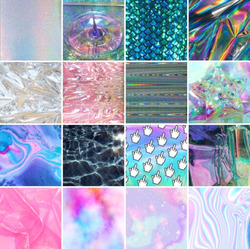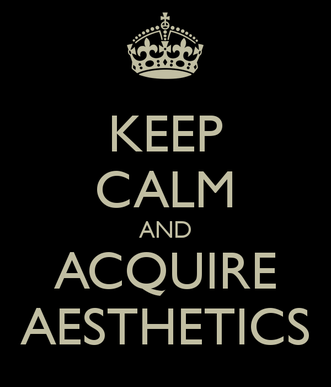
Our art is our voice--the ability to understand the artistry we are surrounded by is our knowledge - Molly Gardner

Aesthetic: “pleasing in appearance; attractive” (Merriam-Webster)
At Oakland School for the Arts we are #blessed. We are surrounded by creativity, inspiration and beauty on a daily basis--aesthetics, in such a cultured environment, are valued. In fact, our beloved high school offers a class on nothing but aesthetics, examining the history and cultural factors that have contributed to our understanding of beauty. Hopefully, regardless of emphasis, OSA students will graduate with the ability to appreciate beauty of all facets and types, and then to reflect that in our own creative pursuits. Our art, many will argue, is our voice--the ability to understand the artistry we are surrounded by is our knowledge.
As one can imagine, the word ‘aesthetic’ is thrown about frequently. Yet lately the term seems to have been tossed around in excess, and haphazardly at that--and OSA students aren’t the only culprits. Plug ‘aesthetic’ into the Tumblr search bar, for example, and images one would think were unrelated pop up by the thousands. (As a side-note, the other suggested search terms that accompany the results include “pale”, “grunge”, and “pastel”). Here is a brief listing of the text posts beloved Tumblr users offer for my “aesthetic” inquiries:
“I have that academically screwed aesthetic.”
“My aesthetic: empty water bottles covering my entire room.”
“Sorry, we can’t be friends, you don’t fit in with my aesthetic.”
Invigorating. Yet the vast majority of these text posts seem to misuse the word, sometimes to romanticize their personal struggles and vices--not the appreciation of a particular style or art. To understand how exactly ‘aesthetic’ is being used colloquially, I interviewed three different OSA students on what they thought ‘aesthetic’ meant, what was aesthetically pleasing to them, and, lastly, what they thought their aesthetic was--and how that influenced their artwork.
My interviewees include sophomore Lali Wilde, freshman Amaya Wilson, and sophomore Max Berk-Wakeman.
Q: How would you define the word ‘aesthetic’?
LW: Well, in actuality it means your perception of beauty...originally it was related to the Ancient Greek canon, and their expectation of what beauty should be, but it’s evolved a lot since then.
AW: Um...something to one that is just extremely pleasing, but in a five-senses type of way.
MBW: Like, um, the look of something. The feel of something.
Q: To you, what is aesthetically pleasing?
LW: I personally like symmetry. I like colors that blend well into each other. I like soft things [laughs]. It’s very subjective for me. Two things can look exactly the same but I’ll find one aesthetically pleasing, and the other not, just based on subtle differences.
AW: Um, things that are aesthetically pleasing to me are things that I have a fond memory of or things that I associate with happy thought.
MBW: Depends on what kind of art. The colors green and gray--light green and gray.
Q: What would you describe your aesthetic as being? And, how does that influence your art or creative process?
LW: Well…[she blushes a little, taking time to collect her thoughts]. I like to mix the dark and creepy and unearthed things in life with the cute and fluffy things in life. I think I do that in the way I dress, but also my art in that I think I express the dark, but in an innocent way.
AW: [smiles]. Can it be like a legitimate Tumblr thing? [laughs]. Vintage grunge; smoky colors. I use things that I associate my aesthetic with, like words and phrases, into my artwork.
MBW: [Looks at me quizzically]. My aesthetic? Um...can you elaborate? I guess I don’t try to dress or act a certain way--to be a certain aesthetic--because I don’t want to be someone else. I’ve never done my hair, or picked clothing out or anything. I don’t know.
Throughout the interview process, one thing remained constant: OSA students, for the most part, can generally identify what an aesthetic is (one would hope so, given the class on the subject). Yet when it comes to themselves, they are at a loss for words, not knowing exactly how to categorize themselves at all. At the very least, it is the hardest question to answer, and the students blushed, embarrassed to talk about themselves. This wasn’t surprising to witness at all. Our society is one where assertiveness of who we are is synonymous with arrogance.
It’s important to mention that this article does not intend to point a finger at thirteen-year-olds who lack substantial self-awareness, nor that people should be expected to confine themselves to oversimplified labels. In reality, young people are changing by the minute--and an understanding of themselves grows as they do. As artists, however, we are empowered by our voices, and it is important that we have some idea of the message we wish to deliver. It is okay if that voice changes over time--as long as it continues to stay there.
My hope for my generation is that we understand aesthetics enough to be able to see beauty in ourselves, and in the art we create. At the very least, the use of ‘aesthetic’--whether, per se, entirely accurate or not--can be a gateway into a deeper understanding of art and culture. As OSA students, we challenge popular ideology everyday: aesthetics, as an appreciation, as a field, is not lacking in substance. There is power in art, and Tumblr is only the beginning.
At Oakland School for the Arts we are #blessed. We are surrounded by creativity, inspiration and beauty on a daily basis--aesthetics, in such a cultured environment, are valued. In fact, our beloved high school offers a class on nothing but aesthetics, examining the history and cultural factors that have contributed to our understanding of beauty. Hopefully, regardless of emphasis, OSA students will graduate with the ability to appreciate beauty of all facets and types, and then to reflect that in our own creative pursuits. Our art, many will argue, is our voice--the ability to understand the artistry we are surrounded by is our knowledge.
As one can imagine, the word ‘aesthetic’ is thrown about frequently. Yet lately the term seems to have been tossed around in excess, and haphazardly at that--and OSA students aren’t the only culprits. Plug ‘aesthetic’ into the Tumblr search bar, for example, and images one would think were unrelated pop up by the thousands. (As a side-note, the other suggested search terms that accompany the results include “pale”, “grunge”, and “pastel”). Here is a brief listing of the text posts beloved Tumblr users offer for my “aesthetic” inquiries:
“I have that academically screwed aesthetic.”
“My aesthetic: empty water bottles covering my entire room.”
“Sorry, we can’t be friends, you don’t fit in with my aesthetic.”
Invigorating. Yet the vast majority of these text posts seem to misuse the word, sometimes to romanticize their personal struggles and vices--not the appreciation of a particular style or art. To understand how exactly ‘aesthetic’ is being used colloquially, I interviewed three different OSA students on what they thought ‘aesthetic’ meant, what was aesthetically pleasing to them, and, lastly, what they thought their aesthetic was--and how that influenced their artwork.
My interviewees include sophomore Lali Wilde, freshman Amaya Wilson, and sophomore Max Berk-Wakeman.
Q: How would you define the word ‘aesthetic’?
LW: Well, in actuality it means your perception of beauty...originally it was related to the Ancient Greek canon, and their expectation of what beauty should be, but it’s evolved a lot since then.
AW: Um...something to one that is just extremely pleasing, but in a five-senses type of way.
MBW: Like, um, the look of something. The feel of something.
Q: To you, what is aesthetically pleasing?
LW: I personally like symmetry. I like colors that blend well into each other. I like soft things [laughs]. It’s very subjective for me. Two things can look exactly the same but I’ll find one aesthetically pleasing, and the other not, just based on subtle differences.
AW: Um, things that are aesthetically pleasing to me are things that I have a fond memory of or things that I associate with happy thought.
MBW: Depends on what kind of art. The colors green and gray--light green and gray.
Q: What would you describe your aesthetic as being? And, how does that influence your art or creative process?
LW: Well…[she blushes a little, taking time to collect her thoughts]. I like to mix the dark and creepy and unearthed things in life with the cute and fluffy things in life. I think I do that in the way I dress, but also my art in that I think I express the dark, but in an innocent way.
AW: [smiles]. Can it be like a legitimate Tumblr thing? [laughs]. Vintage grunge; smoky colors. I use things that I associate my aesthetic with, like words and phrases, into my artwork.
MBW: [Looks at me quizzically]. My aesthetic? Um...can you elaborate? I guess I don’t try to dress or act a certain way--to be a certain aesthetic--because I don’t want to be someone else. I’ve never done my hair, or picked clothing out or anything. I don’t know.
Throughout the interview process, one thing remained constant: OSA students, for the most part, can generally identify what an aesthetic is (one would hope so, given the class on the subject). Yet when it comes to themselves, they are at a loss for words, not knowing exactly how to categorize themselves at all. At the very least, it is the hardest question to answer, and the students blushed, embarrassed to talk about themselves. This wasn’t surprising to witness at all. Our society is one where assertiveness of who we are is synonymous with arrogance.
It’s important to mention that this article does not intend to point a finger at thirteen-year-olds who lack substantial self-awareness, nor that people should be expected to confine themselves to oversimplified labels. In reality, young people are changing by the minute--and an understanding of themselves grows as they do. As artists, however, we are empowered by our voices, and it is important that we have some idea of the message we wish to deliver. It is okay if that voice changes over time--as long as it continues to stay there.
My hope for my generation is that we understand aesthetics enough to be able to see beauty in ourselves, and in the art we create. At the very least, the use of ‘aesthetic’--whether, per se, entirely accurate or not--can be a gateway into a deeper understanding of art and culture. As OSA students, we challenge popular ideology everyday: aesthetics, as an appreciation, as a field, is not lacking in substance. There is power in art, and Tumblr is only the beginning.

